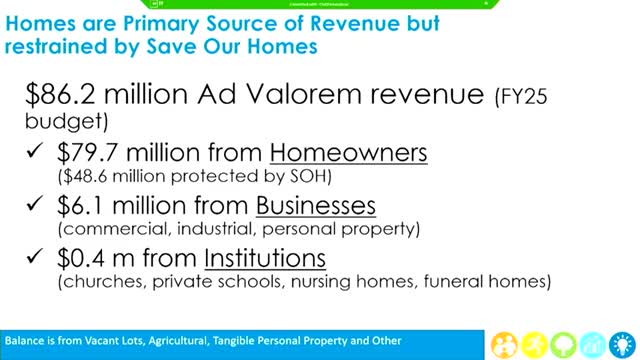City budget proposal reveals significant tax increases for homeowners
June 27, 2024 | Coral Springs, Broward County, Florida

This article was created by AI summarizing key points discussed. AI makes mistakes, so for full details and context, please refer to the video of the full meeting. Please report any errors so we can fix them. Report an error »

During a recent government meeting, city officials discussed the fiscal year 2025 budget, highlighting a total of $86.2 million allocated for ad valorem revenues. Of this amount, $79.7 million is expected to come from homeowners, with $48.6 million protected under the Save Our Homes program. The remaining revenue sources include $6.1 million from businesses and $400,000 from institutions.
City officials noted that nearly 15% of homesteaded properties in the area have been owned for over 25 years, indicating a stable residential community. The proposed millage rate remains unchanged at 6.0232, although rising property values mean that the city will need to advertise a property tax increase. If the proposed budget is not approved, a rollback rate could necessitate cuts of approximately $5.34 million, potentially impacting essential services.
The meeting also addressed the distribution of property tax revenues, with only 30% of tax bills going to the City of Coral Springs, while the majority is allocated to other taxing authorities, including the School Board and Broward County.
In terms of individual tax impacts, homeowners with an average taxable value of $326,000 could see an increase of about $141 in their annual taxes, while condo owners with an average taxable value of $135,000 may experience a smaller increase of approximately $106.
City Manager Frank Babinec provided updates on state funding, indicating that the city expects to receive $1.3 million from the state, which includes $500,000 for improvements to the real-time crime center and $800,000 for the Everglades loop project. However, due to budget constraints, enhancements to the crime center will need to be postponed.
Officials emphasized the importance of transparency in the budgeting process and encouraged community engagement through initiatives like \"Budget and Brews,\" aimed at fostering dialogue between residents and city officials. The meeting concluded with a commitment to maintaining open lines of communication regarding budgetary decisions and their implications for the community.
City officials noted that nearly 15% of homesteaded properties in the area have been owned for over 25 years, indicating a stable residential community. The proposed millage rate remains unchanged at 6.0232, although rising property values mean that the city will need to advertise a property tax increase. If the proposed budget is not approved, a rollback rate could necessitate cuts of approximately $5.34 million, potentially impacting essential services.
The meeting also addressed the distribution of property tax revenues, with only 30% of tax bills going to the City of Coral Springs, while the majority is allocated to other taxing authorities, including the School Board and Broward County.
In terms of individual tax impacts, homeowners with an average taxable value of $326,000 could see an increase of about $141 in their annual taxes, while condo owners with an average taxable value of $135,000 may experience a smaller increase of approximately $106.
City Manager Frank Babinec provided updates on state funding, indicating that the city expects to receive $1.3 million from the state, which includes $500,000 for improvements to the real-time crime center and $800,000 for the Everglades loop project. However, due to budget constraints, enhancements to the crime center will need to be postponed.
Officials emphasized the importance of transparency in the budgeting process and encouraged community engagement through initiatives like \"Budget and Brews,\" aimed at fostering dialogue between residents and city officials. The meeting concluded with a commitment to maintaining open lines of communication regarding budgetary decisions and their implications for the community.
View full meeting
This article is based on a recent meeting—watch the full video and explore the complete transcript for deeper insights into the discussion.
View full meeting